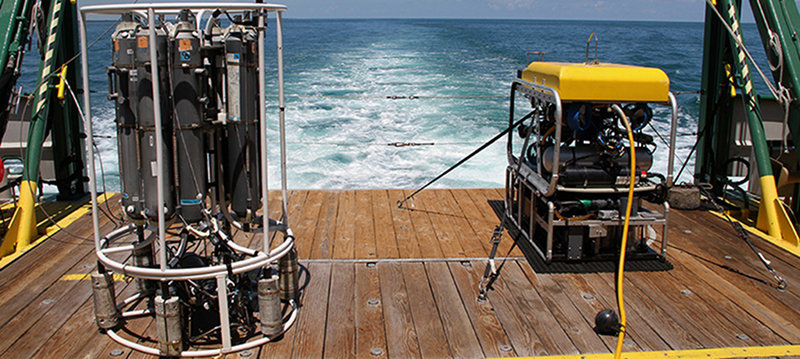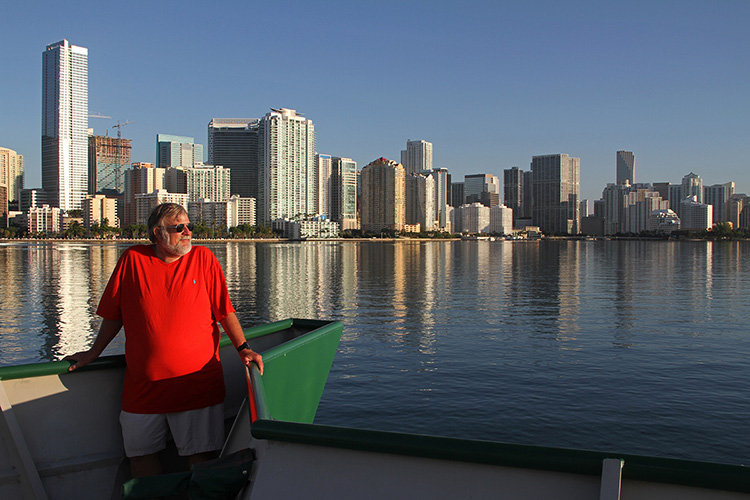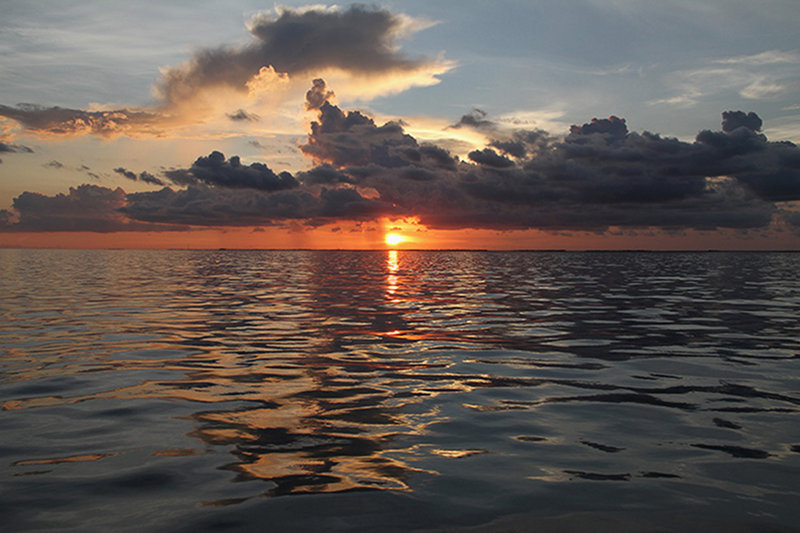
By Brian Cousin - Florida Atlantic University - Harbor Branch
August 22, 2015

The Mohawk ROV (right) shares the deck with a CTD rosette. The ROV will be the workhorse of the mission, diving on Pulley Ridge up to 12 hours per day. Image courtesy of Coral Ecosystem Connectivity 2015. Download larger version (jpg, 575 KB).
It’s hard to believe we’re heading out on the final voyage in the Coral Reef Connectivity study, four years after the first cruise in the summer of 2012. Members of the science crew converged on the Research Vessel F.G Walton Smith in its homeport at the University of Miami. Those of us driving from Florida Atlantic University (FAU) Harbor Branch in Fort Pierce had a pretty good trip: One patch of slow traffic, a thunderstorm here, another one over there, and a pretty bad one directly in our path over Interstate-95.

Chief Scientist Dennis Hanisak takes in the scenery as the University of Miami research vessel F.G. Walton Smith makes its its way through Biscayne Bay past downtown Miami. Image courtesy of Coral Ecosystem Connectivity 2015. Download larger version (jpg, 374 KB).
Lance Horn and Jason White from UNCW (University of North Carolina at Wilmington) Undersea Vehicles Program arrived earlier in the day and already had the Mohawk remotely operated vehicle (ROV) on deck and the ship’s dry lab configured with controls, monitors and displays in the usual way for ROV ops, with one exception. This year, for the first time on a ‘Connectivity’ cruise, the ROV will be collecting samples of organisms from the seafloor for taxanomic research. Harbor Branch professor John Reed and biologist Stephanie Farrington participated in a our NOAA CIOERT cruise in May when samples were collected with the ROV, but this is Chief Scientist Dennis Hanisak’s first experience with the process.
The four-year mission to document and characterize the benthic habitat, the benthic sessile biota (primarily sponges, algae, and coral), and fish populations will continue, with some extensive examination of the region that we visited for the first time last year.
Dubbed ‘Death Valley’ prior to conducting the first-ever ROV dive on it, the team was startled to encounter an abundance of life. We will also fill in some intriguing gaps between areas we have visited before on the east and west edges of the ridge.
Collecting samples of benthic organisms is critical to accurately characterizing the undersea world. In May, members of the Cooperative Institute team found that several of the organisms that had previously been named by sight alone had actually been misidentified. Only until there were tissue samples could the researchers apply taxonomic methods – microscopy, chemistry and DNA analysis.

After a spectacular sunset in the Florida Keys, the light show continued a bit later with almost non-stop heat lightning illuminating the night sky. Image courtesy of Coral Ecosystem Connectivity 2015. Download larger version (jpg, 356 KB).
Today we are in transit to Pulley Ridge. The Walton Smith left the University of Miami dock just before 7 AM and cruised by downtown Miami and Fisher Island before heading south then west through Biscayne Bay and into the Atlantic Ocean. We’ll get to Pulley Ridge via Hawk Channel past Key West, the Marquesas Keys, and the Dry Tortugas. It’s about a 30-hour steam one way.
Excited as we are to get on station and start diving, we are keeping a watchful eye on Danny, the fourth named storm in the Atlantic hurricane season. Today Danny is a Category 1 hurricane on the Saffer-Simpson wind scale. It’s still pretty far away and likely not to be an issue for almost a week, but we need to track the storm’s progress and take whatever evasive action is needed to ensure the safety of the ship and her crew.
Today happened to be a fine summer day in the upper Keys, meaning sunny and very hot. There were pleasure boats all around with people enjoying their Saturday afternoon while we continued to prepare our labs and equipment. Check in for daily updates from the research vessel F.G. Walton Smith off the southwest coast of Florida on the fabulous Pulley Ridge.